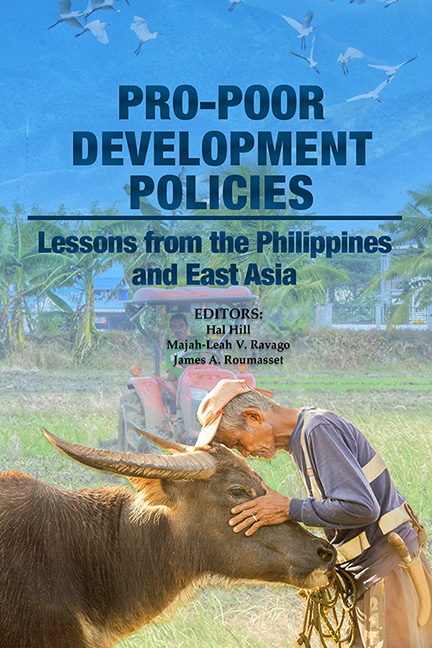Book contents
- Frontmatter
- Dedication
- Contents
- Figures, Tables and Boxes
- Foreword
- Foreword
- Message
- Preface and Acknowledgements
- About the Editors
- About the Contributors
- Acronyms
- Part 1 Introduction and Synthesis
- Part 2 Agricultural and Economic Development
- Part 3 Economic Policies for Achieving Targeted Levels of Living in the Philippines
- Part 4 Inequality and Economic Development
- Part 5 Competition Law and Policy
- Part 6 International Dimensions
- Index
22 - Tariffication and Market Structure: The Case of the Philippine Rice Industry
Published online by Cambridge University Press: 09 January 2024
- Frontmatter
- Dedication
- Contents
- Figures, Tables and Boxes
- Foreword
- Foreword
- Message
- Preface and Acknowledgements
- About the Editors
- About the Contributors
- Acronyms
- Part 1 Introduction and Synthesis
- Part 2 Agricultural and Economic Development
- Part 3 Economic Policies for Achieving Targeted Levels of Living in the Philippines
- Part 4 Inequality and Economic Development
- Part 5 Competition Law and Policy
- Part 6 International Dimensions
- Index
Summary
INTRODUCTION
The Philippine government liberalized rice imports in 2019, ending the import monopoly of the National Food Authority (NFA) and lowering the effective tariff on imported rice. Earlier studies had generally suggested lifting this privilege of the NFA and allowing private sector importation at lower tariffs, among other reforms (Balisacan, Clarete, and Cortes 1992; Roumasset 1999; David 2003; Balisacan and Sebastian 2006; Dawe, Moya, and Casiwan 2006; Sombilla, Lantican, and Beltran 2006; Clarete 2008; David, Intal, and Balisacan 2009; Briones 2018.) While the proposed reform had long been pushed, Philippine lawmakers in several Congresses had consistently considered it not a priority. Not even the country’s obligation to tariffy all quantitative import restrictions under the World Trade Organization’s (WTO) Agreement on Agriculture in 1996 nor a structural adjustment programme with the Asian Development Bank at the turn of the century had pushed lawmakers to reform the NFA’s role in the rice industry. What finally persuaded legislators to pass the Rice Tariffication Law (RTL) in 2019 was the high food price inflation in 2018, which analysts traced to the NFA.
As soon as the RTL went into effect in the first quarter of 2019, private‑sector importers started to import unprecedentedly large quantities of rice. To a price-taking open economy with perfect competition, the domestic price of rice is expected to fall by the percentage reduction of the import tariff rate. However, wholesale prices of rice fell significantly lower than expected in 2019. Furthermore, consumer rice prices dropped by less than that of wholesale rice prices. To top it all, the farmers bore the largest adjustment to rice import liberalization—that is, farm-gate prices of palay plunged the most in percentage terms.
Accordingly, reform opponents claim that the domestic rice market is imperfectly competitive and has remained that way despite import liberalization. With the NFA no longer providing a countervailing check to keep retail prices down, large importers and traders control not only the local supply but also the volume of imported rice.
The policy divide surrounding the RTL has spilled into competing claims on the incidence of gains and losses from the reform.
- Type
- Chapter
- Information
- Pro-poor Development PoliciesLessons from the Philippines and East Asia, pp. 633 - 664Publisher: ISEAS–Yusof Ishak InstitutePrint publication year: 2022

